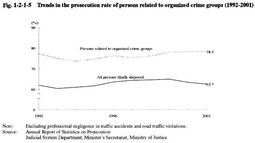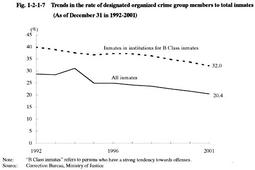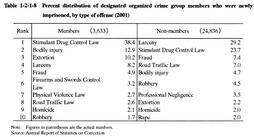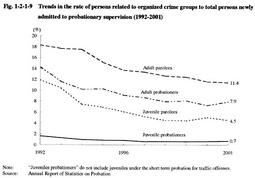| Previous Next Index Image Index Year Selection | |
|
|
3 Treatment of organized crime group members (1) Disposition by public prosecutors offices Fig. 1-2-1-5 shows the trends in the prosecution rate for persons related to organized crime groups (regular or quasi-members who might commit illegal violent acts habitually or in a group; hereinafter the same in 3 (1) of this Section) and for total persons finally disposed during the 10 years from 1992 to 2001. Prosecution rate of total persons finally disposed have been decreasing since 1999, and that of persons related to organized crime groups, on the other hand, have been increasing since 1995, reaching 78.3% in 2001.
Fig. 1-2-1-6 shows suspended prosecution rates by type of major offense of the total persons finally disposed and of persons related to organized crime groups in 2001. Regarding offenses such as assault, Bicycle Racing Law violations, larceny, Horse Racing Law violations, gambling, and lottery violation acts, the suspended prosecution rate of total persons finally disposed exceeded that of persons related to organized crime groups. Fig. 1-2-1-5 Trends in the prosecution rate of persons related to organized crime groups (1992-2001) Fig. 1-2-1-6 Suspended prosecution rate by type of major offense for persons related to organized crime groups (2001) (2) Correctional treatment of designated organized crime group members (a) Admission of designated organized crime group members Fig. 1-2-1-7 shows the trends in the rate of designated organized crime group members (members of " designated organized crime groups, etc ." under the Anti-Organized Crime Group Law; hereinafter the same in 3 (2) of this section) to total inmates at the end of each year over the last decade. The rate of designated organized crime group members to total inmates showed an increase in 1994. However, it has consistently decreased since then, reaching 20.4% in 2001.
Incidentally, the number of designated organized crime group members who were newly imprisoned in 2001 was 3,633 (12.8%), of which 1,188 were leaders, 2,000 were ordinary members, and 445 were of unknown status (Source: Annual Report of Statistics on Correction). Fig. 1-2-1-7 Trends in the rate of designated organized crime group members to total inmates (As of December 31 in 1992-2001) (b) Characteristics of designated organized crime group members who were newly imprisoned (i) Type of offense Table 1-2-1-8 shows the 10 most common offenses committed by designated organized crime group members and by non-members who were newly imprisoned in 2001.
(ii) Term of imprisonment Among newly imprisoned inmates in 2001, examining the percentages by term of imprisonment for designated organized crime group members who were sentenced to imprisonment with or without labor, most of them were sentenced to over 1 year but not more than 2 years, numbering 39.7%, followed by those sentenced to over 2 years but not more than 3 years (23.6%), over 6 months but not more than 1 year (12.8%), over 3 but not more than 5 years (12.7%), over 5 years (7.2%), and not more than 6 months (3.8%), in that order (Source: Annual Report of Statistics on Correction).
(iii) Age Among newly imprisoned inmates in 2001, examining the percentages by age for designated organized crime group members, most of them were 30-39 years of age, numbering 37.2%, followed by those who were 20-29 years of age (24.5%), those who were 40-49 years of age (19.0%), those who were 50-59 years of age (16.5%), those who were over 60 years of age (2.8%), and those who were under 20 years of age (0.1%), in that order (Source: Annual Report of Statistics on Correction).
(iv) Frequency of imprisonment Among newly imprisoned inmates in 2001, examining the percentages by frequency of imprisonment for designated organized crime group members, the highest was "1 time" with 31.7%, followed by "2 times" with 18.5%, "3 times" with 14.3%, "4 times" with 10.1%, "5 times" with 7.2%, "6-9 times" with 14.6%, and "more than 10 times" with 3.6%, in that order (Source: Annual Report of Statistics on Correction).
Table 1-2-1-8 Percent distribution of designated organized crime group members who were newly imprisoned, by type of offense (2001) (c) Treatment in penal institutions In treating designated organized crime group members, penal institutions reinforce the life guidance, lead them to acquire the habit of working, and positively encourage them to break away from crime groups. Paying special attention to strict discipline and maintenance of order, penal institutions take measures for tight security and guard by housing members in the same group in several institutions or transferring them to other institutions, if necessary.
(3) Rehabilitation services for persons related to organized crime groups Fig. 1-2-1-9 shows the trends in the rate of probationers/parolees related to organized crime groups (referring to persons who are considered to have a connection with designated organized crime groups provided in the Anti-Organized Crime Group Law by the time of admission to probationary supervision) to all probationers/parolees newly received, by probation type over the last decade.
The categorized treatment system (see Part 2, Chapter 5, Section 3 ) provides to regard the following probationers/parolees as "Persons related to organized crime groups": (a) The leaders, members, and quasi-members of organized crime groups. (b) Probationers/parolees who previously fell under (a) above and are not considered to have broken away from the groups completely at the point of the admission of probationary supervision. For probationers/parolees who fall under this category, the treatment shall be conducted under the following treatment guidelines: (a) Making an effort to grasp the daily life of the probationers/parolees, such as a concrete relationship with organized crime groups, trends of the groups, under the cooperation of related institutions such as polices. (b) Encouraging probationers/parolees to break away from organized crime groups by controlling the relationship with their friends and acquaintances or by changing their residence in order to improve their environment. (c) Helping probationers/parolees to find proper jobs. (d) Contacting organized crime groups to discuss breaking away of the probationers/parolees from the groups, in consideration of their motivation and background for the participation in the groups, their status in the groups, their family background, and the possibility of breaking away from the groups easily, under the cooperation of related institutions such as the police. Fig. 1-2-1-9 Trends in the rate of persons related to organized crime groups to total persons newly admitted to probationary supervision (1992-2001) Explanation of termsDesignated organized crime groups/designated organized crime groups, etc: Designated organized crime groups and alliances of designated organized crime groups are regulated on the basis of the Anti-Organized Crime Group Law, under which 2 together are called designated organized crime groups, etc. However, all of the 24 organized crime groups that have received designation as of December 31, 2001, are designated as designated organized crime groups, and there are no groups designated as alliances of designated organized crime groups. The Prefectural Public Safety Commission decides whether or not to designate the organized crime groups which satisfy certain requirements as designated organized groups or alliances of designated organized crime groups through specific procedures such as holding public hearings or requesting the consent of the National Public Safety Commission. Stop order: The Anti-Organized Crime Group Law prohibits some acts which have not been regulated under the traditional laws and regulations, such as the act of a designated organized crime group member threatening citizens and demanding money or goods, by flaunting the threat of the designated organized crime groups to which they belong. Orders to stop such acts or to take necessary actions in order to stop them will be issued against the designated organized crime group members who commit such illegal acts by the Prefectural Public Safety Commission. These orders are called "stop orders", and a person who violates such order shall be sentenced to imprisonment with labor, or to fine. Additionally, the partial amendment of the Law in 1997 provides that a person who has a certain relationship with designated organized crime groups but is not a designated organized crime group member shall be also subject to stop orders under the category of quasi-violent acts when he demands money or goods from citizens, by flaunting the threat of the designated organized crime groups to which he is connected. Recurrence preventive order: The Prefectural Public Safety Commission can issue a necessary order which is effective through certain periods within 1 year in order to prevent Anti-Organized Crime Group Law violations, in the case where designated organized crime group members commit the acts which the Anti-Organized Crime Group Law prohibits and where there is a possibility that they repeatedly commit similar acts. This order is known as "a recurrence preventive order", and the penalties for the violation to this order are the same as those of a stop order. Moreover, under the partial amendment of the Law in 1997, quasi-violent acts to demand money or goods by a person who has a certain relationship with designated organized crime groups came to be included in the scope to which recurrence preventive orders could be applied. |




